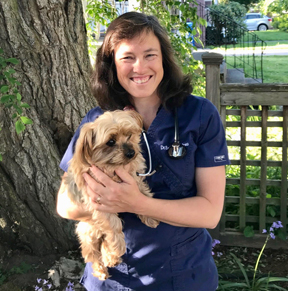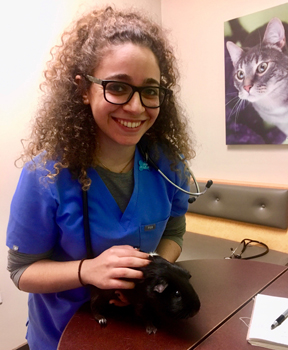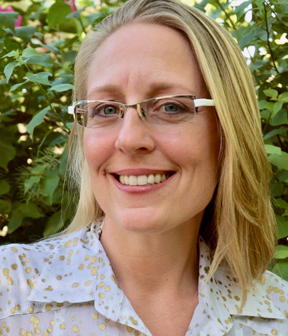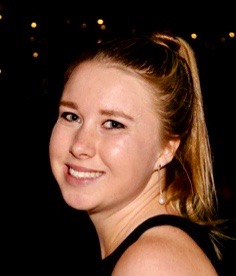
Davidow bug

This year’s Solution for the Profession essay contest for veterinary students, organized by the VIN Foundation, drew 80 excellent entries on the assigned topic: consolidation and its impact on veterinary medicine. Only three writers could win monetary prizes and an automatic posting on the foundation website. I highlighted those students' stories and thoughts in articles published during the past two weeks. This week, I want to introduce you to three more students whose essays made the final round of judging.
Ava Abuchaei
Ava's essay opens with a sweet anecdote about her father's aspirations for his daughter.
"After immigrating to America from Iran, my dad began his own business. He saw business ownership as freeing: allowing him to determine his own hours, pay, management style, and quality of service. Just before starting vet school, I remember him musing to me: 'One day, you’ll open your own veterinary clinic, where you’ll treat hawks, cats, dogs ...'

Photo by Mike Ford
Dr. Beth Davidow, shown with her dog, Biscuit, was one of 10 judges in the essay contest.
"He smiles giddily '... and even lizards!'
"He speaks wistfully, concocting detailed plans on how this fictional clinic operates. But, looking at the changing landscape of clinic ownership, his dream for me may not become a reality."
Ava, who enters her third year at the University of California, Davis, School of Veterinary Medicine this fall, didn’t know what consolidation was when she first heard about the essay contest. Once she learned more, she realized that she had a personal connection to the issue. Ava’s father had owned a clothing import/export business in Los Angeles. The rise of online shopping impacted not just bricks-and-mortar clothes stores but her father’s business, too. She saw firsthand how an industry can be disrupted very quickly by new business forces and technology.
In her parents' native Iran, owning pets is not part of the culture. Growing up, Ava loved animals and eventually convinced them to let her have first canaries, then a hamster. She worked in wildlife rehabilitation prior to veterinary school and has an interest in exotic animals and zoo medicine.
Ava sees changes in human health care as a foreshadowing of what is to come in veterinary medicine. Examining the effects of consolidation in that sector, the picture she sees on the whole is not encouraging. For example, she writes: "In human health care, research suggests that hospital consolidation has raised prices for patients by at least 5%. Alarmingly, consolidated hospitals in close proximity to each other have experienced price increases of 40% or more. A central factor in this trend is simple and concerning: Companies have investors expecting profit. After consolidating an entire area, using their capital to offer lower prices than independently owned practices, and effectively destroying competition, companies face fewer market forces and can then raise prices at-will."
Ava Abuchaei 288

Photo by Maria Virgen
Ava Abuchaei, shown with a guinea pig patient, looked at human health care for clues on how consolidation might affect veterinary medicine.
She offers some specific actions that veterinarians can take to try to maintain a healthy coexistence between consolidated and independent practices. "First, we need to investigate economic factors that fuel the unhealthy, uninhibited race to consolidate and propose legislation to prevent the kind of consolidation that lowers standards of care," she suggests.
"Next, we can demand policies that put more capital in the hands of individuals and promote small business-ownership through subsidies, low-interest loan programs, and student-debt forgiveness for veterinarians. We can additionally advocate for strong enforcement of antitrust laws that are in place to divert the profit-motivated objectives of corporations. We may also form unions or associations of independent practices to collectively fight for quality patient care in our profession."
Ava told me that even as consolidation continues, she hopes that veterinarians will hold positions of power to influence decision-making in the large groups.
While ever larger groups are one trend, she sees a parallel trend toward more individualized care and home visits. She believes clients are willing to pay more for personalized service and quality care. She sees technology as a potential disruptive force, just as it was in the clothing industry, but with a potential to help smaller players compete: Apps and other technology may help make home visits and other veterinary care more efficient and competitive for independent practitioners.
This summer, Ava is teaching in a veterinary-medicine-focused youth camp. She enjoys teaching and hopes to make it part of her career path.
Leigh Kirk
Pursuing veterinary medicine as a career is something that Leigh considered in her youth, but she followed an unconventional route. First, she earned a masters degree in human nutrition and taught online through eCornell. After losing a beloved cat, she started volunteering at a local animal shelter. At the time, hundreds of cats were euthanized there each year.
Wanting to improve the situation, Leigh and her husband founded a nonprofit, Forever Meow, in 2012. The 501c3 organization's mission is to end unnecessary shelter euthanasias of cats in Coachella Valley, California. The group works to help owners correct behavior problems that might otherwise lead to relinquishment. It helps lost cats get home, finds foster homes for cats, and raises funds for medical care.
Leigh Kirk 288

Photo by David Kirk
Leigh Kirk posits that automation technology can help even the playing field for independent veterinarians by enabling them to save money on staffing and giving them more time to build relationships with clients.
Working with veterinarians in her nonprofit role reawakened Leigh’s interest in veterinary medicine. She is now attending Colorado State University College of Veterinary Medicine & Biomedical Sciences, where she soon will enter her second year.
I asked Leigh how she, as a nonprofit client, views different types of practice. Leigh worked with veterinarians in both corporate and independent practices to care for foster cats and to develop care protocols for foster owners. She said she had great experiences with veterinarians in both settings. However, she found that the hoops she had to jump to negotiate discounts and set up care were harder with the large corporate practice than with the independent. The pricing also was different, with the independent practice providing more discounts for fosters.
Leigh anticipates seeing more nontraditional players, along the lines of Walmart, entering the veterinary space, perhaps providing more diversity to the industry.
She also believes that technology could play a part in helping smaller practices be successful. She states in her essay: "If corporate consolidation is the first wave of industry maturation, I believe that current and emerging business automation technology is the second wave and will create a more level playing field of cost for veterinarians who wish to establish and differentiate their practices through their veterinary medical acumen and client relationships."
Leigh elaborated during our discussion: "The data-intensive and intimately collaborative nature of veterinary practice will benefit substantially from the imminent maturation of AI [artificial intelligence], verbal assistants, machine learning, cloud and wearables. All of these could drive automation inflection and client communication and interaction." (By "inflection," Leigh means a tipping point — the point where things change substantially.)
Leigh’s comments on technology are based on trends starting in human health care. Artificial intelligence, which is a hot area of research, could, for example, help triage and streamline diagnosis, especially in imaging. If electronic medical records could understand and record natural language, then translate it into a readable medical record, doctors could have more time with patients and less time on the computer. Thus, automation might actually improve direct client contact.
While technology will be helpful in moving the industry forward, more collaboration among colleagues also is needed. Leigh has seen through her nonprofit how collaboration among people benefits cats. To her surprise, she's found that many veterinarians in private practice are unaware of the challenges present in shelters. If private practice veterinarians and shelter veterinarians worked more closely together, it is possible fewer pets might end up in shelters and more owners of adopted pets might follow through with all care recommendations. Thus, closer ties between all the veterinarians in a community could lead to better overall care.
Leigh says in her essay: "I may be a dreamer, but I can imagine a world where individual veterinarians have choice without compromise, whether to focus on their core medical competency in a corporate business setting or to be a modern 'James Herriot' who can compete profitably if they so choose."
In her own future, Leigh believes she will end up in shelter medicine or a feline-only practice.
Chloe Mitchell
Chloe is a third-year veterinary student at James Cook University in Australia. She used a board-game analogy to open her discussion of veterinary consolidation. Chloe states in her essay: “Larger corporations continue to dominate the industry monopoly board using a plethora of methods. It is plausible to suggest that this business model offers considerable socio-economic advantages; however, its overarching impact on smaller private practices, individual veterinary professionals and students and its extensions to the wider community should be of thorough consideration today and for future players.”
Chloe Mitchell

Blurr Photographics photo
A student in Australia, where veterinary consolidation is occurring as in the States, Chloe Mitchell wonders about the future. In her essay, she asks, "Is this career path now a gamble, with the odds so convincingly stacked against the new players?"
I asked Chloe about how consolidation is playing out in Australia. She told me about the largest entity, Greencross Vets, which owns 150 hospitals in the country. It was traded on the Australian stock market until early this year, when TPG Capital, a private equity firm, bought 100% of shares in February.
After our conversation, I did a bit more research and found that other merger and acquisition veterinary groups in Australia also are rapidly growing. Another large player is the publicly-traded National Veterinary Care, which owns practices in Australia and New Zealand. Also active in the market is Veterinary Partners Australia, which has ties to National Veterinary Associates (a group founded in the U.S. now under majority ownership of Luxembourg-based JAB Investors). Most consolidation in Australia has been taking place in the larger coastal cities.
Chloe and I also talked about differences between the veterinary industries in Australia and the U.S. For example, the student-debt situation is dramatically different. For Australian citizens, a government program caps university fees. It provides loans at nominal interest to students to pay their fees, and ties repayment amounts to income earned. As a result, new veterinarians in Australia are not saddled with the crushing debt of their American counterparts.
Also helping to make their education more affordable is the fact that Australian veterinarians attend university for a total of five years, compared with the eight years that is standard for most in the U.S. (four years for an undergraduate degree plus four years in professional school).
In other ways, the outlook for new veterinarians in Australia and U.S. are similar. As in the U.S., the economy currently is good in Australia, and there is demand for veterinarians. However, Chloe’s sense is that it can be hard to find a practice that is really willing to support learning and provide mentorship for someone right out of school.
Chloe believes success comes down to simple things. As she writes in her essay, "The difference between securing a client long-term with gold standard treatment regularly comes down to an extra five minutes with the right veterinarian and a caring attitude."
When she finishes her degree, Chloe hopes to enter mixed animal practice in a rural area.
Solutions for the Profession contest 2020
If you are a veterinary student interested in competing in the next essay contest, watch the VIN Foundation website for details. If you work with veterinary students, make sure they know about the contest and suggest they submit an essay. Our profession will be strengthened through good ideas and innovative solutions for the future.
About the author: Beth Davidow, DVM, DACVECC, has been an emergency medicine consultant for the Veterinary Information Network since 2003 and also is a member of the VIN Board of Directors. She co-owned two 24/7 multi-specialty hospitals in Seattle, and was the first director of patient quality for BluePearl. Davidow currently is vice president of the American College of Veterinary Emergency and Critical Care, and lectures and consults on veterinary critical care, patient safety and ownership issues. She writes the blog The Veterinary Idealist.